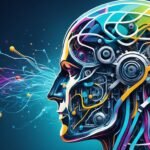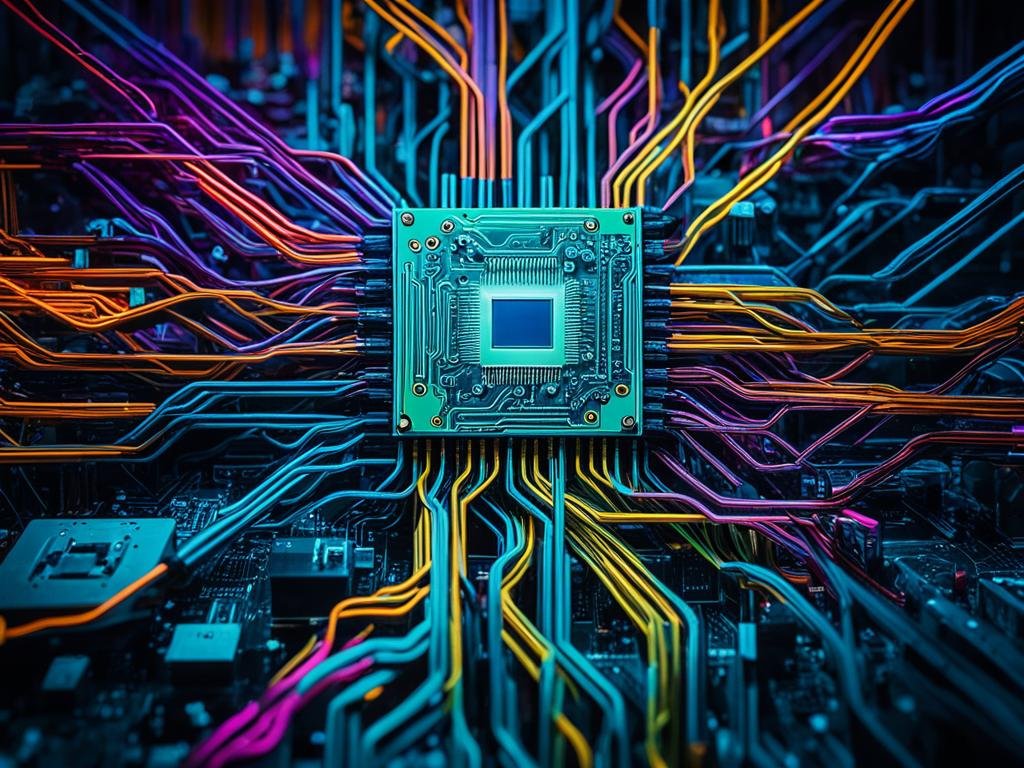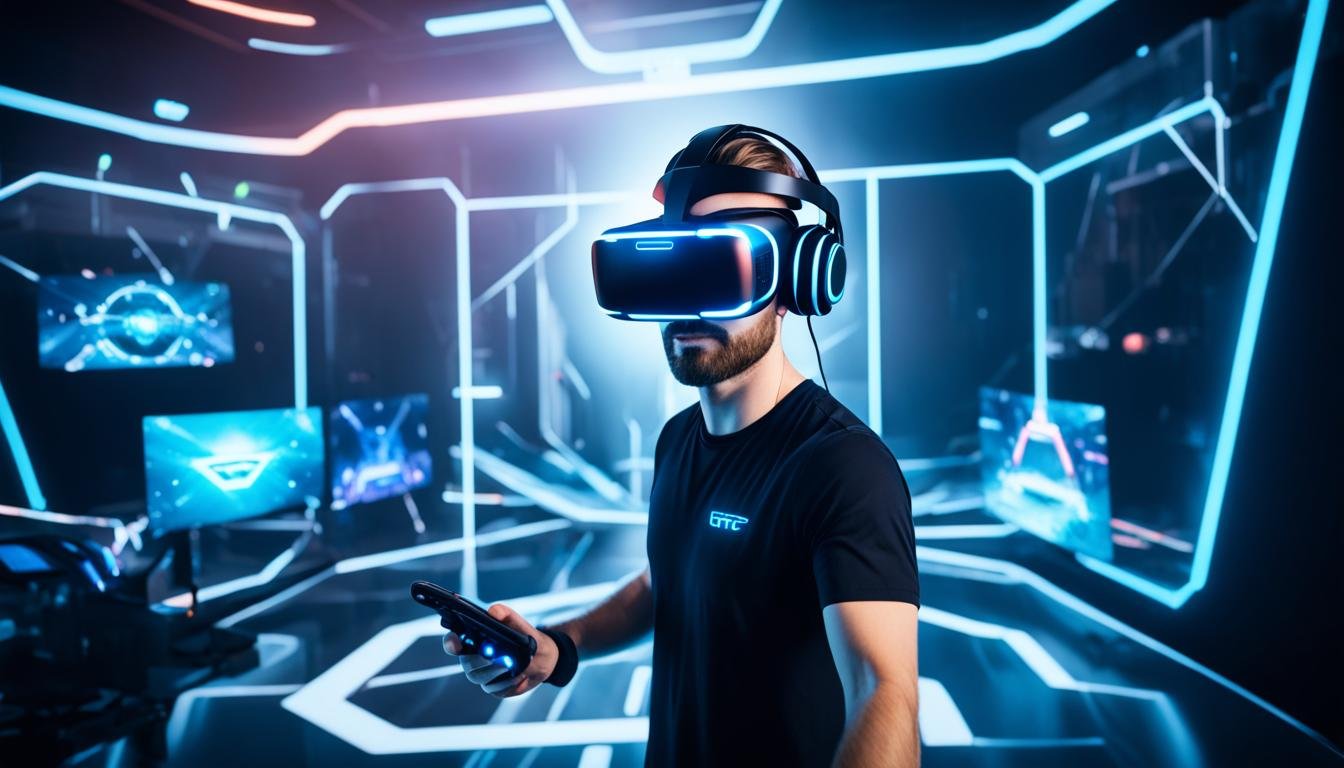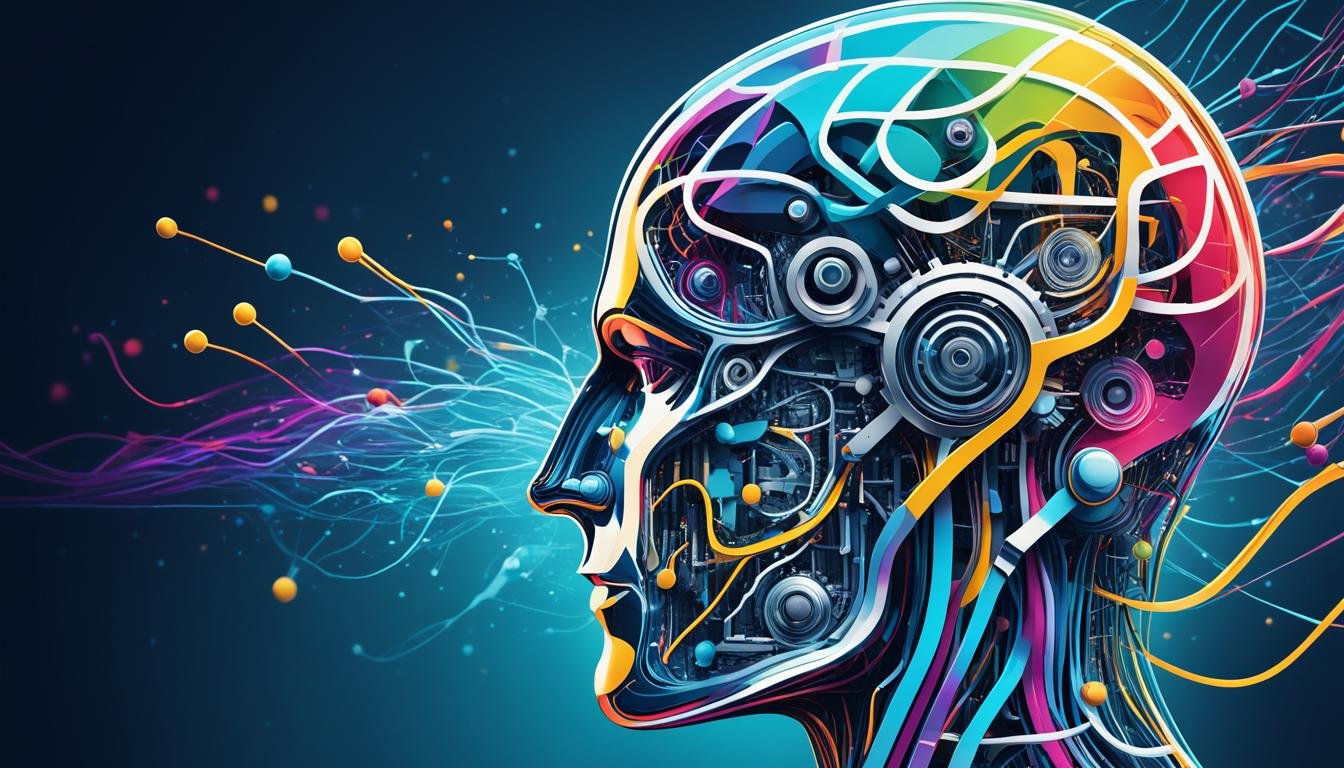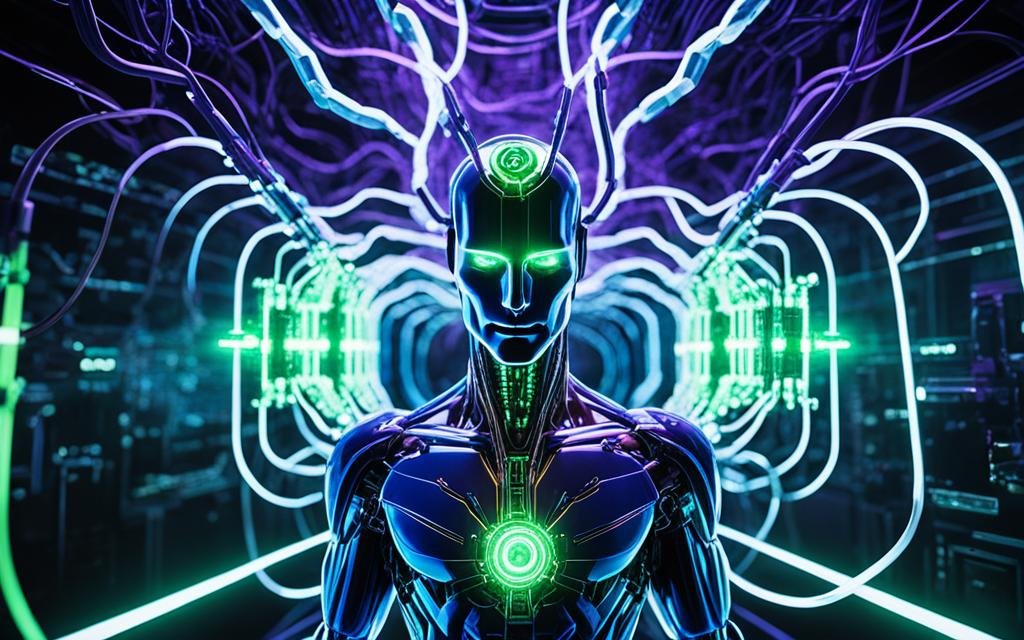Welcome to the Intelligence Age, where artificial intelligence and machine learning are reshaping the world as we know it. The transformative power of AI and ML is revolutionizing every aspect of our lives, from education and business to our personal routines and wellbeing. In this article, we will explore the profound impact of AI and machine learning, and provide insights on how to navigate this era of unprecedented technological advancements.
Artificial intelligence and machine learning have come a long way since their inception. From their historical evolution to their current applications in society, these technologies have disrupted various industries and have become indispensable in our daily lives. Through advanced algorithms, AI can learn and adapt, leading to breakthroughs in fields such as healthcare, finance, and transportation.
In order to understand the world of AI, we will delve into the inner workings of AI algorithms and explore the fascinating realm of neural networks and deep learning. We’ll examine different models of machine learning, such as supervised and unsupervised learning, and their real-world applications. We will also discuss the impact of AI on education, business strategies, and operations, as well as its influence on job roles and industry dynamics.
In addition, we will explore how AI enhances our personal lives by transforming our daily routines and improving our overall wellbeing. From personalized learning to smart home technologies, AI is revolutionizing the way we live and interact with the world around us.
However, with great technological advancements comes the need for strategic planning and policy implications. We will discuss strategies for fostering an AI-savvy workforce, regulating AI to ensure ethical and responsible use, and promoting innovation through inclusivity. By preparing for the AI revolution, we can harness its potential for positive change and navigate the complexities of this intelligence age.
Key Takeaways:
- Artificial intelligence and machine learning have a transformative impact on various industries and daily life routines.
- Understanding AI algorithms and neural networks is essential in comprehending the power of AI and ML.
- Supervised and unsupervised learning models play a crucial role in machine learning applications.
- AI has the potential to reimagine education, business strategies, and operations.
- The integration of AI in personal lives enhances daily routines and overall wellbeing.
The Rise of Artificial Intelligence and Machine Learning
In this section, we will explore the historical evolution of AI technologies and the transformational role of AI in society and various industries. The rise of AI and machine learning has had a profound impact on how we live and work, revolutionizing the way we approach complex problems and unlocking new opportunities for innovation.
Historical Evolution of AI Technologies
The journey of AI technologies dates back to the mid-20th century when researchers began exploring the concept of artificial intelligence. Early developments such as the invention of the electronic computer and the emergence of the field of cybernetics laid the foundation for the evolution of AI. Over the decades, advancements in computational power, algorithms, and data availability have propelled AI technologies to new heights, enabling breakthroughs in areas such as natural language processing, computer vision, and robotics.
AI’s Transformational Role in Society and Industry
The transformative power of AI extends beyond technological advancements. AI has the potential to reshape society and various industries, driving innovation and improving efficiency. In healthcare, AI technologies are revolutionizing disease diagnosis, treatment planning, and personalized medicine. In finance, AI algorithms are enhancing fraud detection, risk assessment, and investment strategies. The transportation industry is leveraging AI for autonomous vehicles and optimizing logistics operations.
AI’s impact on society reaches far and wide, from improving education with personalized learning platforms to enhancing customer experiences through AI-powered chatbots. The industry landscape is also being transformed, with businesses leveraging AI to automate processes, gain insights from big data, and develop new products and services.
As AI technologies continue to evolve and become more sophisticated, it is crucial for society and industries to navigate this new era effectively. In the next sections, we will delve deeper into the inner workings of AI algorithms, explore the world of neural networks and deep learning, and examine the implications of AI on education, business strategies, and the workforce.
Dissecting AI Algorithms: How They Learn and Adapt
In order to understand the inner workings of AI algorithms, it is essential to delve into the fascinating world of machine learning. Machine learning is the foundation upon which AI algorithms are built, enabling them to learn and adapt in response to data.
The first step in the learning process of AI algorithms involves training them with relevant data. Data scientists play a crucial role in developing and refining these algorithms by carefully curating and preparing the training data. This data serves as the fuel that powers the learning process, allowing AI algorithms to make informed decisions and predictions.
But how do AI algorithms actually learn and adapt? One key concept is iteration. AI algorithms go through numerous iterations, continuously analyzing data patterns and refining their models to enhance their performance. Through this iterative process, AI algorithms are able to improve their accuracy and make more insightful predictions.
Feedback is also vital in AI learning and adaptation. Algorithms receive feedback on their performance based on the accuracy of their predictions or decisions. This feedback helps the algorithms adjust their models, leading to better outcomes over time.
To illustrate the learning and adaptation capabilities of AI algorithms, consider the example of image recognition. By training an AI algorithm with a vast amount of labeled images, it can learn to accurately identify specific objects, people, or scenes in unlabelled images. With each iteration and feedback, the algorithm enhances its recognition capabilities, achieving remarkable accuracy.
The power of data science and AI algorithms lies in their ability to learn and adapt. By continuously analyzing data, refining models, and incorporating feedback, AI algorithms have the potential to revolutionize various industries and drive innovation. As this technology continues to evolve, the possibilities for AI algorithms to learn, adapt, and transform our world are virtually limitless.
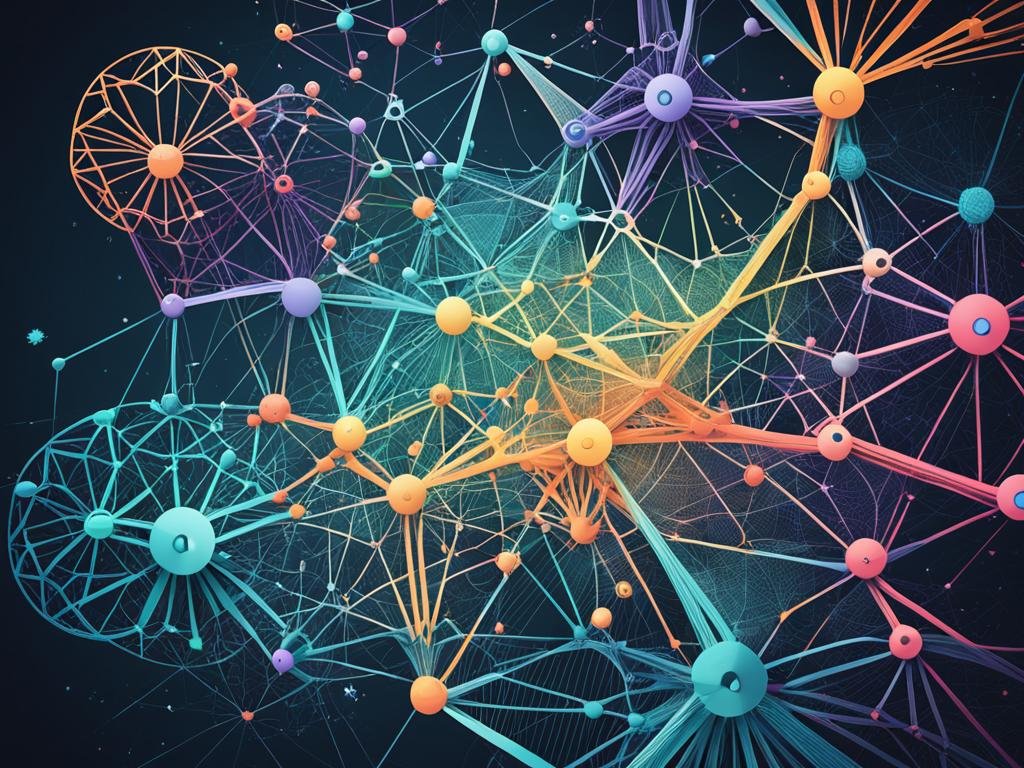
Exploring the World of Neural Networks and Deep Learning
In the realm of artificial intelligence (AI), neural networks and deep learning are revolutionizing the way machines learn and process information. These cutting-edge technologies serve as the building blocks of AI, enabling machines to mimic human brain functions and achieve unprecedented levels of accuracy and efficiency.
Understanding the Building Blocks of AI
Neural networks are at the core of AI systems. They consist of interconnected nodes, or neurons, organized into layers. These layers process and transmit information, allowing machines to recognize patterns, make decisions, and generate outputs based on the input data they receive.
Each neuron in a neural network receives input signals, performs calculations, and produces an output signal. This output signal serves as input for the next layer of neurons, ultimately generating the final output of the neural network.
The connections between neurons determine the flow of information within the neural network. These connections are assigned weights that adjust over time through a process called training. During training, the neural network learns from example data, optimizing the weights to minimize errors and improve accuracy.
Neural networks serve as the foundation for many AI applications, enabling machines to learn complex patterns, recognize objects, understand human language, and even drive cars autonomously.
Applications and Breakthroughs in Deep Learning
Deep learning is a subset of machine learning that relies on neural networks with multiple layers. This depth allows machines to process and interpret complex information, leading to significant breakthroughs in various fields.
One of the most impactful applications of deep learning is in image recognition. Deep learning algorithms can analyze vast amounts of visual data, accurately identifying objects, people, and scenes. This capability has revolutionized industries such as healthcare (e.g., medical imaging diagnosis), security (e.g., facial recognition), and retail (e.g., product recognition).
Another area where deep learning excels is natural language processing, which enables machines to understand and generate human language. Voice assistants, chatbots, and language translation systems employ deep learning algorithms to interpret and respond to spoken or written language, improving communication and accessibility for users.
Furthermore, deep learning has paved the way for advancements in autonomous vehicles. By analyzing sensor data from radars, lidars, and cameras, deep learning models can learn to perceive their surroundings, detect road obstacles, and make real-time decisions for safe and efficient navigation.
The applications of neural networks and deep learning are vast and continue to expand as research and development in AI progresses. As breakthroughs in AI technologies propel us towards a future where machines possess human-like cognitive capabilities, it is crucial to explore the possibilities and implications of these advancements.
Machine Learning Models: Supervised vs Unsupervised Learning
In the field of machine learning, there are various models used to train AI algorithms. Two popular approaches are supervised learning and unsupervised learning. While both methods have their unique characteristics and applications, understanding the differences between them is crucial for effective AI development and implementation.
Supervised Learning:
In supervised learning, the AI algorithm is trained on labeled data, where each input has an associated output. The algorithm learns from these paired examples to make predictions or classify new, unseen data accurately. Supervised learning is commonly used for tasks such as image recognition, speech recognition, and natural language processing.
Table: Supervised Learning
| Algorithm | Applications |
|---|---|
| Linear Regression | Predicting house prices based on features |
| Logistic Regression | Classifying emails as spam or not spam |
| Decision Trees | Diagnosing diseases based on symptoms |
Unsupervised Learning:
In unsupervised learning, the AI algorithm is trained on unlabeled data, where there are no predefined outputs. The algorithm explores patterns and structures within the data to identify similarities or groupings. Unsupervised learning is commonly used for tasks such as clustering, anomaly detection, and recommendation systems.
Table: Unsupervised Learning
| Algorithm | Applications |
|---|---|
| K-means Clustering | Categorizing customer segments for targeted marketing |
| Principal Component Analysis (PCA) | Reducing dimensionality in image or signal processing |
| Association Rules | Discovering purchase patterns in market basket analysis |
By utilizing supervised and unsupervised learning, AI algorithms can be trained to perform a wide range of tasks, from making predictions to discovering insights in data. It is essential to choose the appropriate model based on the nature of the problem at hand and the availability of labeled or unlabeled data.

Education Redefined: The AI Induced Shifts in Learning
In today’s digital era, artificial intelligence (AI) is revolutionizing the field of education, redefining the learning experience for students and teachers alike. With the advent of AI-powered tools and platforms, personalized learning has become a reality, catering to the unique needs and abilities of individual learners.
Personalized Learning through AI
AI offers a new dimension to personalized learning, enabling students to learn at their own pace and in their preferred learning style. By leveraging AI algorithms, educational platforms can analyze vast amounts of data, identifying patterns and tailoring the learning content to meet the specific needs of each student. Through adaptive learning techniques, AI can provide targeted interventions, real-time feedback, and personalized recommendations, fostering a more engaging and effective learning experience.
Teachers, too, benefit from AI-powered tools that can automate administrative tasks and provide valuable insights into students’ progress and areas of improvement. With AI support, educators can allocate more time to individualized instruction and student support, enhancing the overall quality of education.
AI’s Role in Bridging the Educational Divide
One of the most significant impacts of AI in education is its potential to bridge the educational divide. In many parts of the world, access to quality education is limited, particularly in low-income communities and remote areas. AI has the power to address this issue by providing online learning opportunities and removing physical barriers to education.
AI-powered educational tools, such as virtual classrooms and intelligent tutoring systems, can bring quality education to underserved populations, enabling learners to access educational resources, interact with qualified instructors, and engage in collaborative learning experiences. By democratizing education through AI, we can work towards reducing educational inequality and empowering individuals from all backgrounds.
Despite the significant benefits AI brings to education, it is essential to address the challenges and ethical considerations associated with its implementation. Ensuring data privacy, fostering digital literacy, and promoting ethical AI practices are key in creating a safe and inclusive learning environment.
Successful implementations of AI in the classroom have already demonstrated the positive impact of AI-induced shifts in learning. As technology continues to evolve, we can expect further advancements in personalized learning, creating a future where education is truly tailored to each learner’s needs and aspirations.
| Personalized Learning through AI | AI’s Role in Bridging the Educational Divide | |
|---|---|---|
| Benefits |
|
|
| Challenges |
|
|
The Impact of AI on Business Strategies and Operations
In today’s digital age, the impact of Artificial Intelligence (AI) on business strategies and operations cannot be overstated. AI has revolutionized decision making, improved efficiency, and fostered innovation in organizations across various industries. Let’s explore how AI is transforming the business landscape.
AI’s Influence on Decision Making and Efficiency
One of the key benefits of AI in business is its ability to enhance decision making. AI algorithms can quickly analyze large volumes of data, identify patterns, and generate valuable insights that aid in strategic decision making. With AI-powered analytics, businesses can make data-driven decisions that are more accurate, timely, and informed.
A well-known example of AI’s influence on decision making is in customer service. AI-powered chatbots are capable of handling customer queries and providing instant responses, improving response times and customer satisfaction. These chatbots can analyze customer interactions, understand customer sentiment, and deliver personalized recommendations or solutions.
AI also plays a crucial role in improving efficiency in business operations. Automation of repetitive tasks and processes frees up valuable time for employees to focus on higher-value activities. For example, supply chain management can benefit from AI-powered systems that optimize inventory levels, streamline logistics, and predict demand, resulting in cost savings and improved operational efficiency.
Cultivating Innovation with Machine Intelligence
Machine Intelligence, a subset of AI, is driving innovation in organizations. By leveraging machine learning algorithms, businesses can uncover new insights, identify untapped market opportunities, and create disruptive solutions. Machine intelligence enables businesses to adapt to changing customer demands and market trends, fostering a culture of innovation.
One area where machine intelligence is making a significant impact is data analysis. By utilizing AI algorithms, businesses can extract valuable insights from large datasets, enabling them to make proactive business decisions and identify emerging trends. These insights can be used to develop innovative products or services, gain a competitive edge, and anticipate customer needs.
Machine intelligence is also powering advancements in areas such as predictive analytics and recommendation systems. By analyzing vast amounts of data, AI algorithms can accurately predict customer preferences, optimize marketing campaigns, and personalize product recommendations. This level of personalization not only enhances the customer experience but also drives business growth.
| Business Function | AI Applications | Benefits |
|---|---|---|
| Customer Service | AI-powered chatbots | Improved response times, enhanced customer satisfaction |
| Supply Chain Management | AI-driven logistics optimization | Cost savings, improved operational efficiency |
| Data Analysis | Machine learning algorithms | Deeper insights, proactive decision making |
| Marketing | Predictive analytics and recommendation systems | Personalized marketing, increased customer engagement |
The impact of AI on business strategies and operations is undeniable. From optimizing decision making and improving efficiency to fostering innovation through machine intelligence, AI is reshaping how businesses operate in the digital era. Organizations that embrace AI technologies and leverage them effectively will have a competitive advantage in the ever-evolving business landscape.
AI in the Workplace: Reshaping Jobs and Industries
As AI technologies continue to advance, their impact on the workplace is becoming increasingly evident. From job displacement to the creation of new roles, the AI-driven economy is reshaping jobs and industries in profound ways. In this section, we will explore the reality of job displacement and creation, discuss the skills needed to adapt to an AI-driven economy, and examine future job trends influenced by AI adoption.
The Reality of Job Displacement and Creation
One of the key consequences of AI automation is job displacement. As AI systems become more capable of performing routine tasks, many traditional jobs are at risk of being automated. This has led to concerns about unemployment and economic disruption. However, it is important to note that while some jobs may be eliminated, new job opportunities are also created.
For example, roles that involve repetitive and mundane tasks, such as data entry or manual labor, are more likely to be replaced by AI. On the other hand, jobs that require complex problem-solving, creativity, and human interaction, such as decision-making or customer service, are less likely to be automated. As a result, the workforce will undergo a shift towards more fulfilling and value-added roles.
Adapting Skills for the AI-Driven Economy
To thrive in an AI-driven economy, individuals need to adapt their skills and embrace lifelong learning. While certain jobs may be at risk, new opportunities will emerge in sectors that require human skills complementary to AI. Developing skills such as critical thinking, creativity, emotional intelligence, and adaptability will be essential.
Furthermore, individuals should focus on acquiring skills that are difficult to automate. This includes expertise in emerging technologies, such as AI and machine learning, as well as domain-specific knowledge and specialized roles that require a deep understanding of human behavior or complex systems. By upskilling and reskilling, individuals can position themselves for success in the evolving job market.
Future Job Trends Influenced by AI Adoption
The widespread adoption of AI will lead to significant changes in job trends. As automation takes over routine tasks, there will be increased demand for roles that involve managing and leveraging AI technologies. The demand for AI specialists, data scientists, machine learning engineers, and AI ethicists is expected to rise.
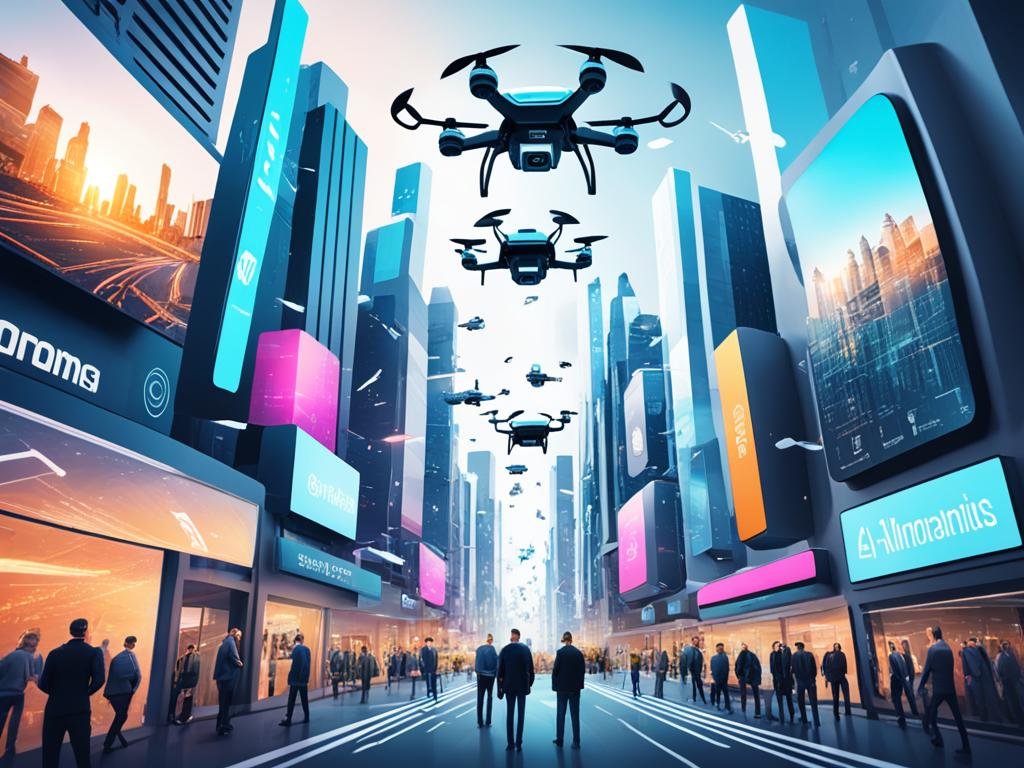
Additionally, there will be a greater emphasis on jobs that require human skills that cannot be easily replicated by AI. These include roles in creative industries, project management, strategic planning, and caregiving. The AI-driven economy will also create opportunities for entrepreneurs and innovators who can leverage AI technologies to create new products and services.
In conclusion, AI is reshaping jobs and industries in the workplace. Job displacement and creation are a reality, requiring individuals to adapt their skills to thrive in an AI-driven economy. Future job trends will be influenced by AI adoption, with an increased demand for AI specialists and roles that require uniquely human skills. By navigating these changes and embracing the opportunities brought by AI, individuals can position themselves for success in the evolving job market.
AI and Our Personal Lives: Enhancing Daily Routines and Wellbeing
Artificial Intelligence (AI) has permeated our personal lives, transforming the way we go about our daily routines and enhancing our overall wellbeing. Through the integration of AI-powered devices and applications, we are experiencing a new level of convenience, efficiency, and personalization.
One area where AI has made a significant impact is in the realm of virtual assistants. Virtual assistants like Siri, Alexa, and Google Assistant have become an integral part of our lives, assisting us with tasks such as setting reminders, managing schedules, answering questions, and even controlling smart home devices. These intelligent companions have simplified and streamlined our daily routines, allowing us to focus on what truly matters.
Speaking of smart home technology, AI has revolutionized the way we interact with our living spaces. From automated lighting and temperature control to voice-activated appliances and security systems, AI-powered smart home devices have not only provided us with greater comfort and convenience but also enhanced our safety and security.
Moreover, AI has also significantly impacted the field of healthcare. From wearable devices that monitor our vital signs and sleep patterns to AI-powered diagnostic tools, the integration of AI in healthcare has enabled early detection of health issues, improved treatment outcomes, and empowered individuals to take charge of their wellbeing.
However, while AI has undoubtedly brought numerous benefits to our personal lives, there are also considerations that need to be addressed. Privacy concerns, ethical considerations, and the potential for dependence on AI are some of the aspects that require careful examination as we embrace these technologies.

“AI-powered devices and applications have become indispensable in enhancing our daily routines, simplifying tasks, and promoting greater wellbeing. From virtual assistants to smart home technology and healthcare monitoring systems, AI has truly transformed our personal lives.”
In conclusion, AI has become a central force in enhancing our personal lives, revolutionizing the way we approach daily routines and promoting overall wellbeing. As we continue to embrace AI technologies, it is essential to strike a balance between the benefits they bring and the ethical and privacy considerations they entail. With careful implementation and responsible usage, AI has the potential to continue transforming our lives for the better.
Preparing for the AI Revolution: Strategies and Policy Implications
As the AI revolution continues to reshape our society and industries, it is crucial to develop effective strategies and implement thoughtful policies to navigate this transformative era. By fostering an AI-savvy workforce, regulating AI technology, and promoting innovation through inclusivity, we can maximize the benefits of AI while ensuring ethical and responsible use in our rapidly evolving world.
Fostering an AI-Savvy Workforce
To prepare for the AI revolution, it is essential to prioritize education and training programs that equip individuals with the skills needed in an AI-driven economy. By investing in continuous learning and upskilling initiatives, we can nurture an AI-savvy workforce capable of adapting to the evolving demands of the digital age.
Regulating AI: Ensuring Ethical and Responsible Use
Regulations play a vital role in ensuring that AI technologies are used responsibly and ethically. Policies should focus on privacy protection, data security, and algorithmic transparency to build trust and accountability. By creating a regulatory framework that addresses these concerns, we can strike a balance between innovation and the well-being of individuals and society as a whole.
Innovation through Inclusivity: AI for Everyone
To fully harness the potential of AI, it is crucial to promote inclusivity and accessibility. By actively involving diverse perspectives in the development and deployment of AI technologies, we can create solutions that benefit everyone in our society. This approach fosters innovation, prevents bias, and ensures that AI-driven advancements are equitable and inclusive.
Conclusion
In summary, the impact of Artificial Intelligence (AI) and Machine Learning (ML) on our society and industries cannot be underestimated. Throughout this article, we have explored the historical evolution of AI technologies, its transformative role in society, and the various applications and breakthroughs in neural networks and deep learning. We have also discussed the different models of machine learning and the impact of AI on education, business strategies, and operations.
As we navigate the AI age, it is crucial for individuals, businesses, and policymakers to understand the potential of AI and machine learning. By staying informed and adapting to AI-driven changes, we can harness this technology’s power for positive change. Furthermore, it is essential to prioritize ethical and responsible AI implementation to ensure its benefits are maximized while mitigating potential risks.
In conclusion, AI and machine learning have the potential to reshape our future, enhance daily routines, and improve various industries. By embracing AI technologies, developing an AI-savvy workforce, and promoting inclusivity and innovation, we can pave the way for a bright future in the intelligence age. Let us continue to navigate the AI age responsibly, so that we may reap the benefits and overcome the challenges that lie ahead.

